
Editor’s note: Usually our blog posts are only about 2,000 or so words. This month’s guest post is much lengthier – but we feel it’s worth it! Grab a cuppa and get comfy, as our guest writer, Marnie Ginsberg, gives a longer but very easy-to-follow overview of the science behind how children learn to read.
Imagine the confusion of neurologists in China in the 30s who were caring for a businessman who suffered a severe stroke. This man was bilingual in Chinese and English, yet after the stroke, he was no longer able to read…Chinese.
However, he could still read English!
What could explain the loss of reading in one language, but not another?
Reading researcher Maryann Wolf details this story in her book Proust and the Squid: The Story of Science of the Reading Brain, as she reveals that this seeming mystery is quite understandable–given what we now know from brain imaging.
First, a little bit of background: The Chinese written language is a logographic language, meaning that Chinese characters represent words or smaller units of meaning.
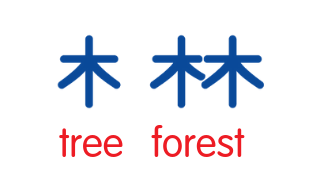
English, on the other hand, is an alphabetic language, meaning that English characters, or letters, represent sounds in words. Letters themselves do not represent meaningful words.
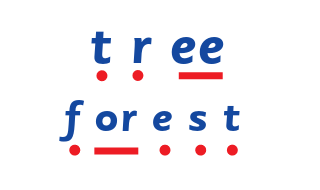
How does this relate to the stroke victim who could read English but no longer Chinese?
This is where it gets interesting, in light of the vast numbers of studies of the last 100+ years on how children learn to read!
Alphabetic languages, such as English, Spanish, and Greek, rely mostly on the left hemisphere of the brain to read words. Chinese, in contrast, also utilises much of the right hemisphere of the brain as well in order to translate the picture-like logographs into meaningful words.
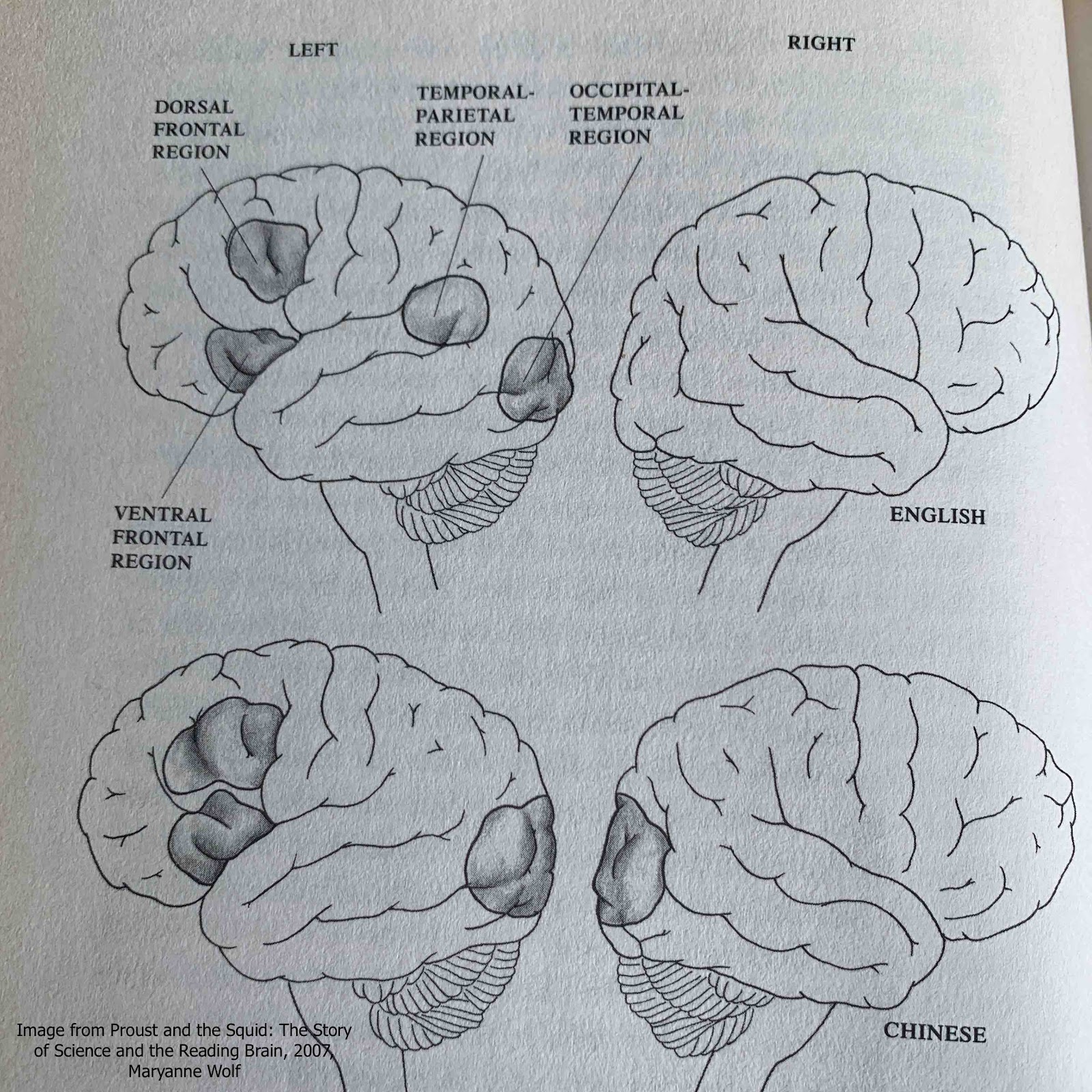 The parts of the brain ‘lit up’ when reading in English and Chinese.
The parts of the brain ‘lit up’ when reading in English and Chinese.It is likely the businessman suffered a stroke on his right posterior hemisphere, but not his left. Thus, Chinese reading was lost, but English reading was retained.
What does this story of a Chinese businessman, brain hemispheres, and modern imaging have to do with how children learn to read English?
Common sense tells us that we read by sight. That learning to read is mostly a visual process, right?
Indeed, good adult readers recognise words by sight so rapidly that they recognise words faster than even letter names. As a result of this accomplishment of our adult reading abilities, a lot of confusion has settled in the land about how we read and how we should teach reading. However, when we only look at what we can observe on the outside (of the brain) and at what we do as mature readers, we miss the real story of how our reading brain develops–at least for alphabetic languages such as English.
Thousands of brain imaging, psychological, and other types of reading research studies have built a mountain of evidence to demonstrate that young readers of alphabetic languages learn to read via sound. Yes, of course, our eyes and visual system are involved. But the heavy lifting in cracking our written code–learning how to convert letters on the page into sounds in words that make meaningful words–is done by our sound processing system, or phonological system.
This blog post will explain the most compelling, and well-researched theory of how learners acquire the ability to read English words. It’s not just what we “see” on the surface!
There are many brains which ‘get by’ in learning to read in English, but these readers struggle as they rely on parts of their brains that are poorly adapted (the right hemisphere, like our Chinese businessman who also read a logographic script) to meet the needs of an alphabetic writing system. Instead, I am going to look at brains that are efficient and accurate at learning to read in an alphabetic system. In the English reading world, there are different types of reading brains, but only one type of brain is highly successful at reading in an alphabetic system.
We’ll examine how to build that type of brain.
When readers like them of all ages receive training on how to read like successful readers, they do learn to read well and their brain changes! (See this research example). This is good news for readers who struggle!
Let’s travel along with a hypothetical five-year-old, Jonah, as he goes about becoming a reader.
Jonah has already spent the first five years of his life learning much of the English language and he’s good at both listening and speaking (for his age). This has been accomplished through many one-on-one conversational turns between his primary caregivers and him. He also learned more advanced words through listening along to storybooks.
This pivotal oral language experience and skill, however, has given him marginal benefit at knowing how to translate specifically the 26 letters of our alphabet into meaningful words that make up sentences and meaningful lines of thought. In other words, if his teacher reads to aloud him Dr. Seuss’ famous The Cat and the Hat , Jonah has no trouble understanding, or comprehending, just what havoc the cat caused for poor Sally and her brother that one rainy day.
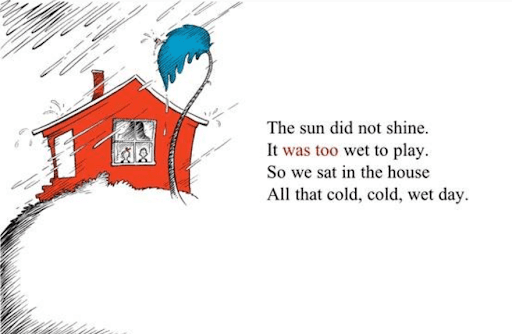
On the other hand, if Jonah’s teacher hands him The Cat and the Hat without having read it to him previously, he is stumped.
He has learned several letter-sounds so he recognises some of the squiggles on the page as having to do with letters and sounds. But he can’t yet translate, or decode, any of them into words that make sense to him.
How can he take a word like ‘sun’ or ‘shine’ and decode those letter strings into meaningful words and concepts?
Given age appropriate oral language abilities, Jonah requires three new key ingredients in order to begin to translate the letters in ‘sun’ into the meaningful word itself. He needs to develop:
The concept of the alphabetic principle means that our written language is a code for sounds. For example the ‘s’ represents the /s/ in ‘sun’. Similarly, the ‘i_e’ represents the /ie/ sound in ‘shine’.
This insight of the alphabetic principle isn’t self-evident to non-readers. Some beginning readers think long words are for words like ‘snake’ because snakes are long. Others create other curious explanations for how to attack, or decode, unfamiliar words. It’s the adult readers job to reveal to the child how our code works.
If a child has never seen a door get unlocked, how will giving her the key to the lock help unless you reveal to her how the lock works? Similarly, advanced readers in the child’s life need to reveal how our written code works. How the words are lifted from the page. Very few children deduce how our written language works on their own.
Helping the young child discover the alphabetic principle can be quite simple. Here’s one way: just drag a pencil or finger along the letter-sounds in a word as you drag out the sounds in the word, like below.
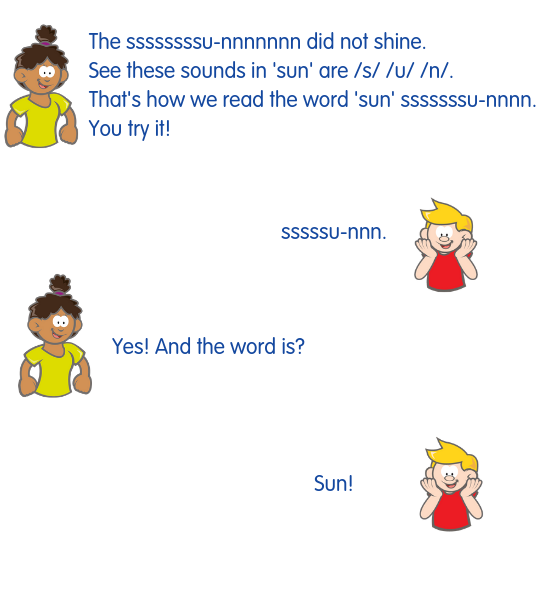
At this point, Jonah, indeed, may not be “reading.” He may just be repeating the word he heard the adult speak aloud. However, he’s beginning to understand how our code works….The squiggles on the page are a code for sounds in words; that’s the alphabetic principle.
It’s an “aha!” that every beginning reader should be taught. The two skills that follow help the alphabetic principle move beyond just a concept to rapid facility with decoding–the alphabetic principle in action.
Watch this short example of a young student in one of her first encounters with the alphabetic principle. As she goes through this word building activity, she’ll also be gaining knowledge in the 2 upcoming ingredients: letter-sound knowledge (phonics) and phonemic awareness.
The second much-needed skill is letter-sound knowledge. Jonah needs to know that when he sees the letter ‘s’, he’s likely going to say “/s/”. Not “/m/”. Not “/oy/”. Not “sit”.
This information is also called phonics knowledge. For instance, in The Cat and the Hat’s first sentence, Jonah will need to learn various phonics information, such as:



In order to know that ‘shine’ consists of the sounds /sh/ /ie/ /n/, Jonah will need to deconstruct ‘shine’. He’ll need to convert ‘sh’ into /sh/ and the other letter combinations (or graphemes) into their relevant sounds (or phonemes).
To move from beginning reader to advanced reader, Jonah will need to learn which phonemes are tied to over 240 graphemes, such ‘t,’ ‘m,’ ‘er’, ‘oa’, ‘ck’, or ‘gn’.
Much more than just the 26 alphabet sounds, right?
It IS a lot to learn in the early years of learning to read, and it’s made more complicated by the fact that some graphemes can represent more than one phoneme (i.e., ‘ow’ = /oa/ or /ow/ in ‘snow’ or ‘cow’).
But that’s not all!
Many phonemes represent more than one grapheme, as in the /oa/ sound: ‘go’, ‘home’, ‘show’, ‘boat’, ‘toe’, etc. Learning these grapheme-phoneme correspondences takes practice reading and doing word work activities, which is why computerised games that teach all of these phonics spellings, such as Phonics Hero, can be so beneficial (get access to the free resources with Phonics Hero Teacher Account or a 7-day trial as a parent).
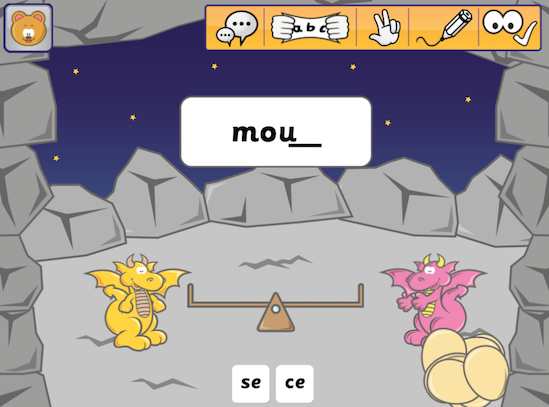
Phonics Hero offers Jonah the possibility of fun while his brain makes links (paired-associate learning) between the 240+ graphemes he will need to learn in order to become a strong adult reader and recognise words like ‘infantile’, ‘prevaricate’, and ‘gregariousness’.
If you’re new to thinking about how children learn to read, you may not be aware that the reading education field has been susceptible to philosophical debates that have become so heated as to be termed the “reading wars.” These debates mostly center on the place of phonics instruction in a beginning readers’ classroom.
Some (the “phonics” side) claim that phonics information needs to be explicitly and systematically taught. Others (the “whole word” or “whole language” side) purport that this information is better deduced through the reading of authentic texts and whole word learning. A more recent version of the whole-word line of thought emphasises that reading instruction which centers on levelled texts, contextual guessing, understanding of the whole text, and occasional phonics lessons, will result in better outcomes.
These arguments have fuelled little good and mostly chaos for classroom teachers and, even worse, low performance for those students most in need of systematic phonics instruction. [See, for instance, over 60% of U.S. fourth-graders are not proficient according to federal assessments.]
The winds are turning, however.
The evidence-base on the essential need for systematic phonics instruction has reached such a mountain’s height that more and more leaders, teachers, and parents are aware of the research. Tellingly, the U.S. based International Literacy Association (ILA) has just released a nuanced position paper validating the importance of explicit and systematic phonics despite previously endorsing some leaders and texts that have historically thumbed their noses at the contemporary research base on how children learn to read words.
Finally, the concept of the alphabetic principle and knowledge of phonics information are insufficient alone to learn to read words. The developing reader also needs to perceive the individual sounds in words; we call this oral language ability, phonemic awareness.
For instance, Jonah needs to be able to recognise that the word ‘play’ can be segmented into the sounds /p/ /l/ and /ay/. Or, he might be able to hear three segmented sounds, such as /w/ /e/ /t/ and blend those sounds together to hear the word, “wet.” These are just two types of phonemic awareness. See this little girl demonstrate:
Phonemic awareness allows the child to utilise our written code. It’s the engine that allows the phonics knowledge to be put into play.
When Jonah encounters the word, ‘shine’, he has to:
Many young beginning readers cannot do this without support! They lack phonemic blending ability.
In addition, Jonah also needs to be able to quickly separate, or phonemically segment, the sounds in words. If he can perceive that ‘sun’ is three sounds: /s/ /u/ and /n/, he can connect each of those sounds to their respective spellings. He may already have memorised how to read and spell the word; he’s cracked the code for the word ‘sun’.
Phonemic blending and segmenting were emphasised in recent decades in research syntheses, such as the U.S. National Reading Panel Report and the so-nicknamed Rose Report from the U.K., as the main phonemic awareness vehicles to learning to decode. Indeed, they are essential.
But further research has revealed that one more phonemic awareness skill is still needed – phonemic manipulation.
Phonemic manipulation is the ability to add, delete, or change phonemes in words. For example, ask a beginning reader orally “what is ‘slip’ without the /l/ ” and you’ll likely receive little more than a blank stare. However, ask any skilled 4th-grade reader and they’ll be able to do the task easily.
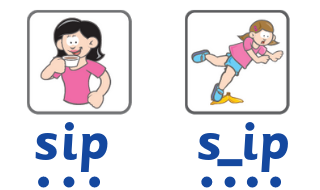
This higher level phonemic awareness skill is harder than blending and segmenting and is a better predictor of reading achievement than just blending segmenting. David Kilpatrick makes the case that phonemic proficiency – rather than phonemic awareness – better describes the skill that sets apart the strong from the weaker reader. “Proficiency” draws out the concept of speed of processing, which appears to be essential for both decoding and automatic word identification.
All the mechanisms for why phonemic proficiency makes such a difference are not yet fleshed out by research, but here are two partial explanations. First, when Jonah encounters a word for the first time and he tries to decode it, he’s likely to make an error in his first guess. However, if he deletes an attempted vowel sound and adds another option to test out another possible word, he’s relying on advanced phonemic awareness skills (i.e., phonemic proficiency).
For example, take the word ‘shine’ again. Jonah may or may not have been explicitly taught the spelling pattern of ‘i_e’ for /ie/. Even if he had been taught it, he may not notice the ‘e’ at the end of the word when he first observes the ‘i’ spelling in ‘shine’.
As a result, his first attempt to read ‘shine’ sounds like “shin”, which is a reasonable choice if the ‘e’ ending is ignored. Have no fear, though.
Jonah is searching for meaning as he reads. He realises that, “The sun did not shin,” makes no sense. He attempts to correct his mis-reading by dropping the /i/ sound in “shin” and replaces it with another common “i” sound -/ie/.
Now the word sounds like “shine” and that fits the sentence. He is pleased with his second attempt and moves on. Thus phonemic proficiency has served him well in his decoding process.
Jonah’s reading of “shine” can be used to describe the theory of how word learning occurs – the self-teaching hypothesis (popularised by Share, 1995). Jonah’s teacher or parent likely provided Jonah with the ingredients to be able to decode some words himself: the alphabetic principle, phonics knowledge, and phonemic awareness.
But Jonah deduced that ‘i_e’ must be /ie/ in ‘shine’. Through attacking most of the word correctly but getting stuck with the vowel sound, he figured out the information he was lacking that must be needed to make a meaningful word in the sentence, “The sun did not shine.”
In that “positive learning trial” (Jorm and Share, 1983), he may have learned consciously or subconsciously that ‘i_e’ is likely the sound /ie/. He may have also learned that ‘shine’ is the correct spelling of the word. He may have even learned a spelling pattern of the two sounds in ‘ine’ to more quickly read ‘twine’, ‘mine’,’fine’, or ‘spine’ in the future.
This spelling and reading-word-parts information may have become part of his orthographic learning. Orthographic learning, or orthographic mapping, is the correct knowledge of our spelling system: that the spelling ‘i_e’ is the /ie/ in ‘shine’ and ‘like’ and that ‘whose’ is spelled with a ‘wh’ ‘o_e’ and ‘s’. The reading brain “orthographically maps” the concept of ‘wh’ to ‘whose’ for future reference.
A typically developing reader can decode a word for the first time, such as ‘shine’ and recall the way it looks for automatic future reading with as few as one to four exposures of the word. Readers develop an abstract concept of the word and its interior parts so that they might recognise the same word in their very next exposure even if the word is written:
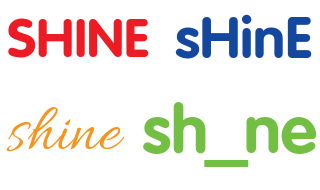
This process of decoding → orthographic mapping → automatic word recognition is not just a one-way street, however.
As the developing reader orthographically maps more and more words in our language, she develops deeper phonemic awareness. The very print itself fixes the abstract phoneme representations into a concrete visual form – letters! This helps explain how reading itself has been demonstrated to reciprocally interact with phonemic development. This bi-directional relationship between decoding and phonemic awareness is yet another explanation for why strong readers have phonemic proficiency. The act of reading accurately, and then orthographically mapping so many words and letter combinations, has developed their processing of sounds in words. The phonemes in words have become inextricably linked with print.
Thus, we’ve come full circle with phonemic awareness. A rudimentary amount of it is necessary to really understand the alphabetic principle and to begin to decode unfamiliar words. But correct reading itself also trains the reader in stronger and stronger phonemic awareness. This is the other route in which we understand that phonemic proficiency is developed as students move from beginning to advanced reading.
Good readers develop it through the process of accurately decoding words by sound. Poor readers who rely on mostly visual-only information to recall a word (in other words ignoring some or all of the phonetic cues in the spelling of the word) are not able to orthographically map the words in their brain. They don’t have tight sound-symbol (or phoneme-grapheme) connections on which to hang the information they may have just read in a word.
Jonah is not the only one who is still learning to read words. Even you, mature reader, may be learning to recognise rapidly new words, such as new medical terms, foreign names, or high falutin vocabulary. 😉
Let’s experiment with this, shall we? Try to read this text with some made-up words:
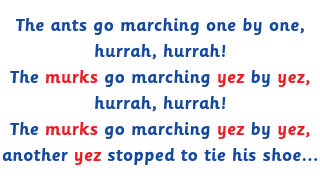
Did you deduce how to pronounce ‘murks’ and ‘yez’? Did it take much time?
For most good readers, these words were likely phonologically decoded in very little time. Your brain quickly cracked the code on the spelling of “murks” and translated them into phonemes, to then be pronounced accurately.
You likely broke it down into…

….and blended them together and arrived at /merks/ as a reasonable pronunciation for ‘murks’.
That’s the process that a beginning reader goes through every time she reads an unknown word–the early words, such as ‘pen’ and the later words such as ‘stupendous’.
Let’s test your ability to do the same as Jonah, shall we?
Choose the correct word for the blank:

Which did you choose?
They are all viable spelling options for the sound /er/!
And, if you’ve just read this text one time through, you’ve only seen the proposed pronunciation for the ‘ants’ substitute 4 times in your entire life.
But, if you’re a good reader, you probably can recall which spelling is the “correct” one:

You didn’t deduce it alone from sound-based cues. All the choices are reasonable options for the /er/ sound. The ‘i’ spelling is often the /er/ sound as in ‘bird’, ‘shirt’, ‘skirt’, ‘girl’, or ‘quirky’, for instance.
And, although less common, ‘ear’ is the /er/ sound in many common words, such as ‘earth’, ‘learn’ and ‘earn’. (There are even several other possibilities for the /er/ sound.)
You likely chose ‘murk’ because your amazing brain had already orthographically mapped the /er/ sound to ‘ur’ and ‘murk’ as yet another letter string to tie to a specific group of sounds and a specific semantic concept (i.e., an ant).
Researchers have even tested how long this memory trace could last. At least 30 days! Possibly much, much more (Share, 2004).
But this would have been much harder for you to orthographically map if you didn’t have good code-cracking ability and speed (phonemic proficiency). OR, it would be harder if the word had no code, no logic, to cue you.
Consider, what if I had written this:

Would you remember after 5 minutes whether ‘ants’ was:
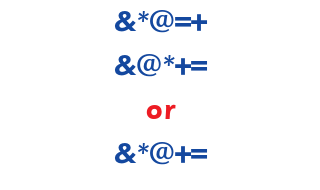
Without a meaningful code, and without a system for cracking it, you’re left to process this new word with other systems of the brain. And that visual-only system has not proven able to allow readers to learn the 40 to 70 thousand words mature readers recognise at a glance.
Phonological decoding, or sound-based decoding, draws the reader’s attention to the orthographic elements of each new word. I call it noticing the “inside parts” of words. That ‘ur’ is the /er/ sound we use in ‘murks’.
You got it now, right? 😉
Orthographic learning is item-based, not stage-based. Even though you are likely capable of reading thousands of words, and might be considered at the most “advanced” stage of a reader, you still had to go through the same process to mentally pronounce ‘murks’ that any 5-year-old would have to do to pronounce ‘bird’.
Are you not at an advanced stage of reading?
Certainly!
You didn’t recognize ‘murks’ by sight because it was your first exposure. It was a new item in your mental orthographic system.
Whether we are a beginning or advanced reader, we’re all pioneers on the frontier of learning new words, or new orthographic patterns – for our own reading brain.
Today may be the day that you learn, not only to read ‘murks’ but also:


Each novel word is a new item to be decoded. Yet another code to be cracked. And, within just a handful of exposures, that word will likely be orthographically encoded, able to be recognised and pronounced in a split second. But perhaps you may have to check with a dictionary if you don’t know how to pronounce the above words.
Now we’ve journeyed from China to analysing Jonah’s process of reading simple words such as ‘sun’ and ‘shine’. Hopefully, you understand a bit better the route that Jonah takes to move from beginner reader, who slowly decodes one word at a time, to that of an advanced reader who can recognise in milliseconds, literally, thousands upon thousands of words.
The brain’s amazing system for learning to read words takes Jonah from matching sound (phoneme) to symbol (grapheme) over and over again till the words become memorised (orthographically mapped). Words that are easily recognized. Now they are read by sight in the blink of an eye.
The Self-Teaching Theory helps explain a number of confusing issues in the teaching of reading and reading research. For example, how can it be that research so convincingly demonstrates that students benefit from being taught phonics information explicitly AND children rapidly learn way more phonics information than they could possibly be explicitly taught?
In Kindergarten or Year One, the average child might know 25-100 words. By first grade perhaps they can read about 500-600. By fourth grade, the number has jumped to 4,000. By 12th grade, a good reader may know as many as 30,000 to 70,000. That’s exponential growth.
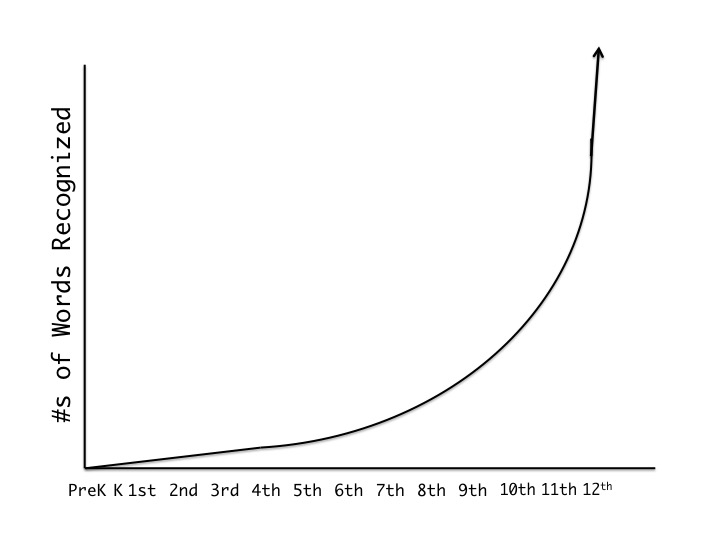
Could teachers have explicitly taught (and students learned) that many spellings and words? Over 18 words a day if one assumes 40,000 words by the end of high school. It is hard to imagine that many words could be covered, and learned, through explicit teaching in school.
No worries. A better understanding of how children learn to read is that they benefit from a sufficient amount of:
How can this happen with all the unexpected spellings that we have in English?
The good reader’s brain adjusts to the occasional quirk because she’s drawing from her sound decoding brain and her meaning making brain. She hits upon a word and within a few exposures she has bound those sounds and symbols together. And that work helps not only with the word at hand, but also with other spelling patterns and words in words she’ll uncover in the future.
Share explains it this way:
Because neither contextual guessing nor direct instruction, in and of themselves, are likely to contribute substantially to printed word learning, the ability to translate printed words independently into their spoken equivalents assumes a central role in reading acquisition. According to the self-teaching hypothesis, each successful decoding encounter with an unfamiliar word provides an opportunity to acquire the word-specific orthographic information that is the foundation of skilled word recognition. A relatively small number of (successful) exposures appear to be sufficient for acquiring orthographic representations, both for adult skilled readers (Brooks, 1977) and young children (Manis, 1985; Reitsma, 1983a, 1983b). In this way, phonological recoding [“decoding”] acts as a self-teaching mechanism or built-in teacher enabling a child to independently develop both (word)-specific and general orthographic knowledge. Although it may not be crucial in skilled word recognition, phonological recoding may be the principal means by which the reader attains word reading proficiency…”
(1995, p. 155).
Most of those who struggle with this process often don’t have:
Better dissemination of the what research suggests about how to teach reading would likely dramatically change reading achievement for upwards of 50% of children in English-speaking countries.
A smaller minority of learners can have good instruction in these three key word-learning instructional elements and still struggle with learning to read. They may have weaker abilities in the phonemic processing domain. They may also have weaker abilities to make orthographic representations with just a few exposures. This type of reader could be identified as “dyslexic” and benefit from more intensive instruction and practice in learning about the code. But that brings us to a topic for another day.
In describing the process that the good reader undergoes in order to become a fluent reader, I didn’t discuss many specifics for instruction itself. The above is more a description of the processes that a developing reader’s brain goes through. There are actually many instructional routes that would provide these key ingredients for good word reading acquisition.
But research has given us a nearly slam-dunk case on the critical features that we should look for when we consider reading instruction:
Ideally, these key features of instruction are present for the child from the beginning of her reading journey so that she gets an early, strong start to reading. Then she’ll be much more likely to enjoy reading, read more, and continue to develop her reading comprehension through a lifetime of wide reading (Stanovich, 1986).
If one or several of these important elements are missing, most children will struggle to become fluent. Consider these four elements for your child or your class of students and ensure that all ingredients are in the mix.
Finally, I leave you with a test – do you remember how to spell our made-up word for ‘ants’?

To explore the Phonics Hero resources, sign up for a Teacher Account or Parent Account. To learn about how children learn to read with Marnie, visit Reading Simplified.
What a comprehensive and scientifically-based overview of the learning-to-read process! I love that Marnie addresses the critical importance of phonemic proficiency, orthographic mapping, and the self-teaching hypothesis in addition to systematic phonics instruction. I work with students with dyslexia and other learning challenges and understanding how those three elements affect the learning-to-read process has significantly improved my effectiveness as a teacher over the past two years. I wish this article had been written years ago! This article will now become one of my go-to resources to recommend to colleagues and parents.
Thank you Jennifer!! It’s so go to hear that you’re using these principles to help make readers and that this post can serve you and other teachers. 🙂
Are you saying there are over 200 graphemes in the English language? If so, what is your linguistic research to support your claim?
Heather, I’m not a linguistic expert. However, I believe that while linguists would quibble about exactly how many graphemes (letter-sounds or individual spellings) are in the English language, most estimates I’ve seen in a variety of sources refer to over 200, at least.
When I googled “English graphemes,” this was the first listing:
http://www.speechlanguage-resources.com/support-files/soundstographemesguide2.pdf
The author of the above document lists several graphemes on pages 18-21.
I’ve also seen Louisa Moats refer to 240+ graphemes–likely in her book Speech to Print–and I did find her referring to 250 graphemes here on page 20:
https://www.aft.org/sites/default/files/periodicals/Moats.pdf
Hope this helps your concern.
Marnie,
I was so interested to read this and am even more sure of the phonetic based way of teaching children to grasp the fundamentals of beginning to read.,paramount.
I now teach children with disabilities after some 35 or more years of teaching.
The phonetic approach ,research and evidence based support weee integral parts of my teacher training in the late 7o’s and early 80’s.
Let’s just accept your great knowledge.
Sue, thanks for your kind words! I’m glad this resonated with you. May your students become good readers!!